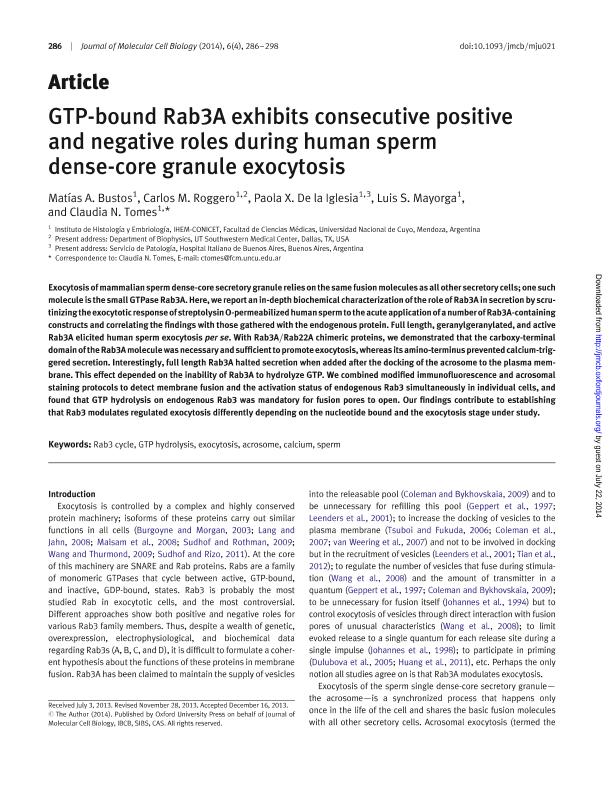Mostrar el registro sencillo del ítem
dc.contributor.author
Bustos, Matias Alberto

dc.contributor.author
Roggero Savoini, Carlos Marcelo

dc.contributor.author
De la Iglesia, Paola X.
dc.contributor.author
Mayorga, Luis Segundo

dc.contributor.author
Tomes, Claudia Nora

dc.date.available
2018-01-04T21:00:26Z
dc.date.issued
2014-08
dc.identifier.citation
Bustos, Matias Alberto; Roggero Savoini, Carlos Marcelo; De la Iglesia, Paola X.; Mayorga, Luis Segundo; Tomes, Claudia Nora; GTP-bound Rab3A exhibits consecutive positive and negative roles during human sperm dense-core granule exocytosis; Oxford University Press; Journal of Molecular Cell Biology; 6; 4; 8-2014; 286-298
dc.identifier.issn
1674-2788
dc.identifier.uri
http://hdl.handle.net/11336/32373
dc.description.abstract
Exocytosis of mammalian sperm dense-core secretory granule relies on the same fusion molecules as all other secretory cells; one such molecule is the small GTPase Rab3A. Here, we report an in-depth biochemical characterization of the role of Rab3A in secretion by scrutinizing the exocytotic response of streptolysin O-permeabilized human sperm to the acute application of a number of Rab3A-containing constructs and correlating the findings with those gathered with the endogenous protein. Full length, geranylgeranylated, and active Rab3A elicited human sperm exocytosis per se. With Rab3A/Rab22A chimeric proteins, we demonstrated that the carboxy-terminal domain of the Rab3A molecule was necessary and sufficient to promote exocytosis, whereas its amino-terminus prevented calcium-triggered secretion. Interestingly, full length Rab3A halted secretion when added after the docking of the acrosome to the plasma membrane. This effect depended on the inability of Rab3A to hydrolyze GTP. We combined modified immunofluorescence and acrosomal staining protocols to detect membrane fusion and the activation status of endogenous Rab3 simultaneously in individual cells, and found that GTP hydrolysis on endogenous Rab3 was mandatory for fusion pores to open. Our findings contribute to establishing that Rab3 modulates regulated exocytosis differently depending on the nucleotide bound and the exocytosis stage under study.
dc.format
application/pdf
dc.language.iso
eng
dc.publisher
Oxford University Press

dc.rights
info:eu-repo/semantics/openAccess
dc.rights.uri
https://creativecommons.org/licenses/by-nc-sa/2.5/ar/
dc.subject
Rab3 Cycle
dc.subject
Exocytosis
dc.subject
Sperm
dc.subject
Chimaera
dc.subject
Gtp Hydrolysis
dc.subject
Acrosome
dc.subject
Calcium
dc.subject.classification
Otras Ciencias Biológicas

dc.subject.classification
Ciencias Biológicas

dc.subject.classification
CIENCIAS NATURALES Y EXACTAS

dc.title
GTP-bound Rab3A exhibits consecutive positive and negative roles during human sperm dense-core granule exocytosis
dc.type
info:eu-repo/semantics/article
dc.type
info:ar-repo/semantics/artículo
dc.type
info:eu-repo/semantics/publishedVersion
dc.date.updated
2017-12-29T14:11:29Z
dc.journal.volume
6
dc.journal.number
4
dc.journal.pagination
286-298
dc.journal.pais
Reino Unido

dc.journal.ciudad
Oxford
dc.description.fil
Fil: Bustos, Matias Alberto. Consejo Nacional de Investigaciones Científicas y Técnicas. Centro Científico Tecnológico Conicet - Mendoza. Instituto de Histología y Embriología de Mendoza Dr. Mario H. Burgos. Universidad Nacional de Cuyo. Facultad de Cienicas Médicas. Instituto de Histología y Embriología de Mendoza Dr. Mario H. Burgos; Argentina
dc.description.fil
Fil: Roggero Savoini, Carlos Marcelo. Consejo Nacional de Investigaciones Científicas y Técnicas. Centro Científico Tecnológico Conicet - Mendoza. Instituto de Histología y Embriología de Mendoza Dr. Mario H. Burgos. Universidad Nacional de Cuyo. Facultad de Cienicas Médicas. Instituto de Histología y Embriología de Mendoza Dr. Mario H. Burgos; Argentina. University of Texas; Estados Unidos
dc.description.fil
Fil: De la Iglesia, Paola X.. Consejo Nacional de Investigaciones Científicas y Técnicas. Centro Científico Tecnológico Conicet - Mendoza. Instituto de Histología y Embriología de Mendoza Dr. Mario H. Burgos. Universidad Nacional de Cuyo. Facultad de Cienicas Médicas. Instituto de Histología y Embriología de Mendoza Dr. Mario H. Burgos; Argentina. Hospital Italiano; Argentina
dc.description.fil
Fil: Mayorga, Luis Segundo. Consejo Nacional de Investigaciones Científicas y Técnicas. Centro Científico Tecnológico Conicet - Mendoza. Instituto de Histología y Embriología de Mendoza Dr. Mario H. Burgos. Universidad Nacional de Cuyo. Facultad de Cienicas Médicas. Instituto de Histología y Embriología de Mendoza Dr. Mario H. Burgos; Argentina
dc.description.fil
Fil: Tomes, Claudia Nora. Consejo Nacional de Investigaciones Científicas y Técnicas. Centro Científico Tecnológico Conicet - Mendoza. Instituto de Histología y Embriología de Mendoza Dr. Mario H. Burgos. Universidad Nacional de Cuyo. Facultad de Cienicas Médicas. Instituto de Histología y Embriología de Mendoza Dr. Mario H. Burgos; Argentina
dc.journal.title
Journal of Molecular Cell Biology
dc.relation.alternativeid
info:eu-repo/semantics/altIdentifier/doi/http://dx.doi.org/10.1093/jmcb/mju021
dc.relation.alternativeid
info:eu-repo/semantics/altIdentifier/url/https://academic.oup.com/jmcb/article/6/4/286/919408
Archivos asociados
